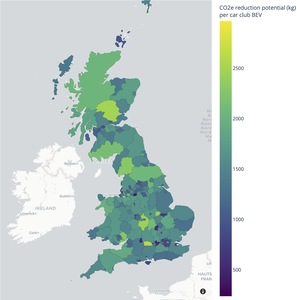1. Questions
In response to the climate emergency, the transition towards electrification is accelerating globally. Its potential to be sustainable and transformative is augmented if combined with shared mobility (Sprei 2018). Local policymakers across the United Kingdom have declared climate emergencies, but may have influence over a mere third of their jurisdictions’ emissions, with road transport a key action area (CCC 2020). The levers local policymakers can pull to reduce emissions from transport vary spatially, especially in rural areas, where there is less public transport and higher baseline emissions (Marsden et al. 2020). With public transport in decline outside London (Friends of the Earth 2023), shared electric mobility or electric ‘car clubs’ can be a sustainable transport policy alternative (CCC 2020).
Commercially-run car clubs operate predominantly in denser urban areas (Dill and McNeil 2021; Shaheen and Cohen 2013), taking advantage of greater demand, complementary transport options, and more public charging infrastructure (Marsden et al. 2019; Shaheen, Cohen, and Farrar 2019). There is a lack of research on rural car sharing, and its potential to meet policy objectives such as reducing carbon emissions (De Paepe, Van Acker, and Witlox 2023). Evidence suggesting that car sharing reduces private vehicle mileage and ownership varies by city and business model and is mainly sourced from urban examples (Jochem et al. 2020; Marsden et al. 2019; Mock 2023; Shaheen, Cohen, and Farrar 2019). Engagement with policymakers in rural Oxfordshire as part of a pilot of electric car clubs revealed frustration with this lack of evidence of potential impact or rural examples beyond qualitative case studies[1] (TSU 2025). To start to fill this gap, we developed a basic tool using open data and conservative assumptions that visualises place-specific benefits from electric car clubs.
2. Methods
Carbon emissions from vehicles, whether private or shared, are dependent upon fuel type and mileage. An Irish study found that private car electrification can have greater environmental benefits outside cities due to higher average mileage per vehicle and lower EV uptake (Charly and Caulfield 2025). The DfT publishes quarterly statistics on registered vehicles by fuel type for local authorities (LA) in Britain[2] and annual statistics on vehicle miles travelled (VMT) on county and unitary roads. Conversion factors are published annually (Table 1) to calculate carbon emissions from passenger vehicles based on fuel type per kilometre (mile) and UK electricity production (DESNZ 2024).
For each LA, total car VMT on the roads is divided by total cars registered then multiplied by the emissions from an ‘average’ car, as derived from the proportion of vehicles of each fuel type in the registered car fleet.[3] PLEASEM shows the reduction in carbon emissions if this average mileage was instead driven in a fully electric or hybrid car. Shared cars usually record greater annual mileage[4] and tend to reduce the annual VMT of multiple drivers of private cars, likely resulting in greater carbon savings. However, as we do not account for induced demand or indirect carbon emissions that might result from sharing (Amatuni et al. 2020), the tool assumes a straight switch.
We also use small area statistics from England and Wales to calculate changes in car ownership rates and electric vehicle (EV) uptake by households (DfT 2024; ONS 2021). Such statistics have been used convincingly to test policy scenarios for emissions reduction in complex models (Brand et al. 2025). Our simplified version assumes each electric car club vehicle replaces nine private vehicles. This is deemed a conservative estimate based on an amalgamation of data summarised in Table 2.[5]
Finally, PLEASEM depicts the change in the rate of EV uptake by decile if inclusive of nine frequent car club users. Local clustering of EV early adopters suggests a neighbour effect (Morton et al. 2018), so an electric car club nearby could act as an additional policy lever to accelerate EV uptake.
3. Findings
Our tool, PLEASEM, shows that urban LAs are likely to achieve relatively lower direct carbon emissions’ reductions than some suburban and rural authorities, even assuming a switch from private car mileage rather than from public transport or new trips. The LAs with the most potential are not the most remote, but lack populous cities. Furthermore, the average annual mileage on local roads has a greater impact on the variation in emissions reductions between LAs than the cleanliness of that LA’s private fleet. The tool’s users can adjust the annual mileage to estimate more precisely carbon emissions savings, e.g. if they have mileage data from a local electric car club to benchmark.
The tool also shows the impact on EV uptake and car ownership at the Middle layer Super Output Area (MSOA) level per shared vehicle.[6] The variation between MSOAs is a product of the total fleet and population, average cars per household and level of EV ownership.
PLEASEM demonstrates that the benefits of electric car clubs vary by location. Initial feedback from local, rural policymakers is that PLEASEM helps them visualise and benchmark these benefits. It provides a base that can be updated and further developed to offer additional place-specific outputs.
Acknowledgements
This work was funded by the Department for Transport’s Transport Research and Innovation Grant 2024, number 33642, administered by the Connected Places Catapult. The authors would also like to thank Co Wheels for sharing their data and all those who provided feedback during the tool’s development process so far, including Jenny Figueiredo at Oxfordshire County Council and Gordon Stokes, honorary research associate at the TSU.
The most recent data was for Quarter 2, 2024.
See Github repository: https://github.com/HBudnitz/PLEASEM
See supplementary information.
See supplementary information for detailed descriptions.
These are statistical areas of 2-6,000 households. The tool also aggregates this to LA level.




